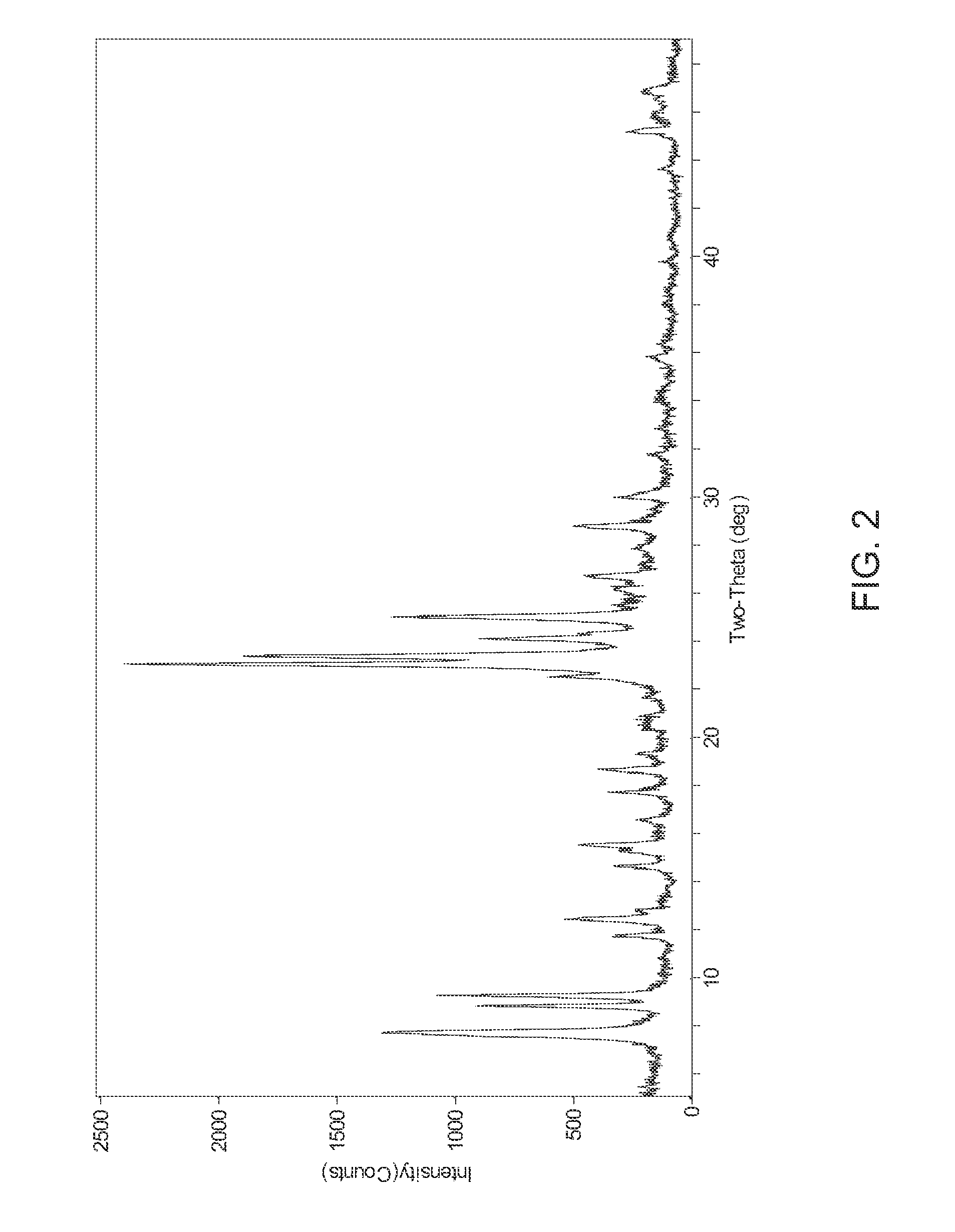Dehydrocyclodimerization using uzm-44 aluminosilicate zeolite
a technology of aluminosilicate zeolite and cyclodimerization, which is applied in the direction of hydrocarbon preparation catalysts, physical/chemical process catalysts, organic chemistry, etc., can solve the problem of limited diffusion, promote oligomerization and aromatization reactions, and promote dehydrogenation functions. , the effect of high yield of aromatics and hydrogen
- Summary
- Abstract
- Description
- Claims
- Application Information
AI Technical Summary
Benefits of technology
Problems solved by technology
Method used
Image
Examples
example 1
[0050]5.28 g of NaOH, (97%) was dissolved in 111.88 g water. 1.16 g Al(OH)3, (29.32 wt.-% Al), was added to the sodium hydroxide solution. Upon the mixture becoming a solution, 33.75 g Ludox AS-40 was added and the solution was stirred vigorously for 1-2 hours and then cooled to 0° C.-4° C. Separately, 8.89 g 1,5-dibromopentane, (97%) was mixed with 9.56 g 1-methylpyrrolidine, (97%) to form a second mixture. The second mixture was added to the cooled mixture to create the final reaction mixture. The final reaction mixture was vigorously stirred and transferred to a 300 cc stirred autoclave. The final reaction mixture was digested at 170° C. for 120 hours with stirring at 100 rpm. The product was isolated by filtration. The product was identified as UZM-44 by XRD. Analytical results showed this material to have the following molar ratios, Si / Al of 11.77, Na / Al of 0.21, N / Al of 1.02, C / N of 7.75. The product generated by this synthesis was calcined under flowing air at 600° for 6 hour...
example 3
[0052]The final reaction mixture was vigorously stirred and transferred to a 5 gallon stirred autoclave. The product was isolated by filtration. The product was identified as UZM-44 by XRD. Analytical results showed this material to have the following molar ratios, Si / Al of 11.77, Na / Al of 0.21, N / Al of 1.02, C / N of 7.75. The product generated by this synthesis was calcined under flowing air at 600° for 6 hours. Analysis for the calcined sample shows a BET surface area of 301 m2 / g, pore volume of 0.238 cm3 / g, and micropore volume of 0.142 cm3 / g.
example 4
[0053]A UZM-44 in the H+ form was loaded into a vertical steamer. The UZM-44 was exposed to 100% steam at 725° C. for 12 hours or 24 hours. The starting UZM-44 had a BET surface area of 340 m2 / g, pore volume of 0.301 cm3 / g, and micropore volume of 0.154 cm3 / g. After 12 hours of steaming, the UZM-44 was still identified as UZM-44 by XRD though the intensity of the first 3 peaks had increased to very strong, very strong—strong, and very strong—strong respectively. All other peaks were at positions and intensities described in Table B. The material had a BET surface area of 274 m2 / g, pore volume of 0.257 cm3 / g, and micropore volume of 0.127 cm3 / g. After 24 hours of steaming, the UZM-44 was still identified as UZM-44 by XRD though the intensity of the first 3 peaks had increased to very strong, very strong—strong, and very strong—strong respectively. All other peaks were at positions and intensities described in Table B. The material had a BET surface area of 276 m2 / g, pore volume of 0....
PUM
| Property | Measurement | Unit |
|---|---|---|
| mole ratio | aaaaa | aaaaa |
| mole ratio | aaaaa | aaaaa |
| mole ratio | aaaaa | aaaaa |
Abstract
Description
Claims
Application Information
 Login to View More
Login to View More - R&D
- Intellectual Property
- Life Sciences
- Materials
- Tech Scout
- Unparalleled Data Quality
- Higher Quality Content
- 60% Fewer Hallucinations
Browse by: Latest US Patents, China's latest patents, Technical Efficacy Thesaurus, Application Domain, Technology Topic, Popular Technical Reports.
© 2025 PatSnap. All rights reserved.Legal|Privacy policy|Modern Slavery Act Transparency Statement|Sitemap|About US| Contact US: help@patsnap.com



